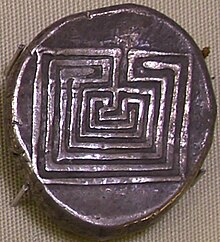Labyrinth

In Greek mythology, the Labyrinth (Greek: Λαβύρινθος, Labýrinthos)[a] was an elaborate, confusing structure designed and built by the legendary artificer Daedalus for King Minos of Crete at Knossos. Its function was to hold the Minotaur, the monster eventually killed by the hero Theseus. Daedalus had so cunningly made the Labyrinth that he could barely escape it after he built it.[1]
Although early Cretan coins occasionally exhibit branching (multicursal) patterns,[2] the single-path (unicursal) seven-course "Classical" design without branching or dead ends became associated with the Labyrinth on coins as early as 430 BC,[3] and similar non-branching patterns became widely used as visual representations of the Labyrinth – even though both logic and literary descriptions make it clear that the Minotaur was trapped in a complex branching maze.[4] Even as the designs became more elaborate, visual depictions of the mythological Labyrinth from Roman times until the Renaissance are almost invariably unicursal. Branching mazes were reintroduced only when hedge mazes became popular during the Renaissance.
In English, the term labyrinth is generally synonymous with maze. As a result of the long history of unicursal representation of the mythological Labyrinth, however, many contemporary scholars and enthusiasts observe a distinction between the two. In this specialized usage maze refers to a complex branching multicursal puzzle with choices of path and direction, while a unicursal labyrinth has only a single path to the center. A labyrinth in this sense has an unambiguous route to the center and back and presents no navigational challenge.[5][6][7][8]
Unicursal labyrinths appeared as designs on pottery or basketry, as body art, and in etchings on walls of caves or churches. The Romans created many primarily decorative unicursal designs on walls and floors in tile or mosaic. Many labyrinths set in floors or on the ground are large enough that the path can be walked. Unicursal patterns have been used historically both in group ritual and for private meditation, and are increasingly found for therapeutic use in hospitals and hospices.[citation needed]
Etymology[]
Labyrinth is a word of pre-Greek origin whose derivation and meaning are uncertain. Maximillian Mayer suggested as early as 1892[9] that labyrinthos might derive from labrys, a Lydian word for "double-bladed axe".[10] Arthur Evans, who excavated the palace of Knossos in Crete early in the 20th century, suggested that the palace was the original labyrinth, and since the double axe motif appears in the palace ruins, he asserted that labyrinth could be understood to mean "the house of the double axe".[11] The same symbol, however, was discovered in other palaces in Crete.[12] Nilsson observed that in Crete the double axe is not a weapon and always accompanies goddesses or women and not a male god.[13]
The association with "labrys" lost some traction when Linear B was deciphered in the 1950s, and the Mycenaean Greek version of "labyrinth" appeared as da-pu-ri-to (